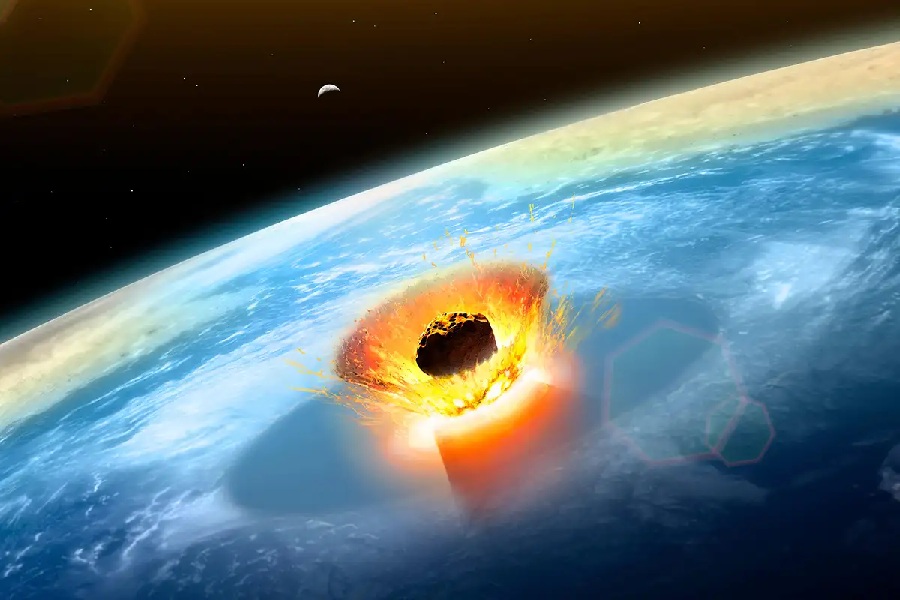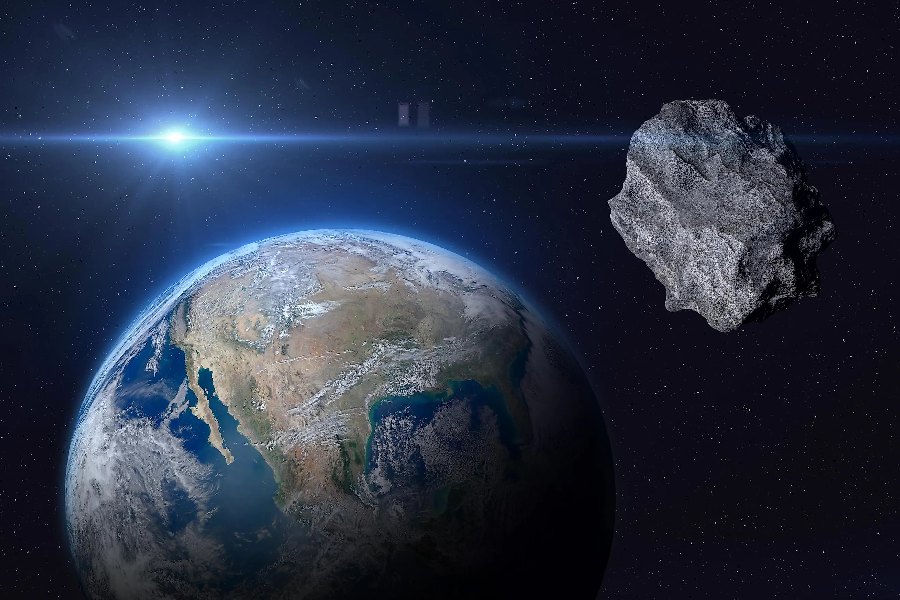The extinction of the dinosaurs about 66 million years ago remains one of science’s great mysteries. A leading explanation is that an asteroid impact abruptly transformed conditions on Earth, causing a mass die-off. But how big was the asteroid that killed the dinosaurs? Where is the asteroid that killed the dinosaurs?
In the upcoming paragraphs, we will explore the innovative methods scientists employed to model the size of the asteroid responsible for the extinction event. Additionally, we will vividly describe the aftermath of the asteroid’s impact and explore how it probably triggered the widespread mass extinction.
So, let’s embark on this journey of discovery!
How Big Was the Asteroid That Killed the Dinosaurs?
The asteroid that ended the dinosaurs’ reign was colossal, measuring about 6 miles (10 kilometers) wide. It collided with Earth around 66 million years ago, triggering catastrophic effects.
The impact resulted in massive destruction, including intense heat, wildfires, and a global dust cloud that blocked out sunlight. These environmental changes led to the extinction of dinosaurs and many other species. This marked a significant turning point in Earth’s history.

Size estimates: Scientific investigations
The Nobel laureate physicist Luis Alvarez was a pioneer in investigating the asteroid impact scenario. In 1980, his research group discovered rare iridium deposits around the world. Their layer matched when dinosaurs went extinct. This suggested an extraterrestrial collision caused a global catastrophe.
Alvarez used the sparse evidence then available to produce an early estimate of the asteroid’s size. He proposed it was about 6 miles (10 kilometers) wide when it struck Earth. His team’s groundbreaking hypothesis spurred renewed interest in solving the mystery of what wiped out the dinosaurs.
Advances in impact modeling and simulation
In recent years, computer models have advanced, providing more precise simulations of asteroid collisions. Scientists meticulously programmed various physical factors, including asteroid size, speed, impact angle, and location. These models also considered the intricate details of debris dispersion and the resulting environmental ripple effects.
By fine-tuning parameters in these simulations, researchers successfully aligned the models with evidence discovered in the geological record. The study of recently discovered melted rock deposits has further refined our understanding, offering tighter constraints on the magnitude of the impact.
Improved size calculations: Geology and computer simulations
After carefully analyzing all the collected data, refined modeling capabilities developed over 30+ years now allow for more accurate estimates. Based on simulations and ground evidence, the likely range for the diameter of the threatening asteroid spans between 6 and 50 miles (11 and 81 kilometers).
Although uncertainties persist regarding the exact figure, advanced techniques enable us to establish tighter constraints. The upper limit surpasses early expectations of the colossal size of the space rock that triggered global firestorms and led to years-long darkness, ultimately marking the end of the age of the dinosaurs.
Impact origin
The asteroid that wiped out the dinosaurs likely formed over 4 billion years ago during the early stages of the Solar System, gathering metals and rocky material through accretion, much like how Earth and other planets were formed. For eons, it resided peacefully in the main asteroid belt, situated between Mars and Jupiter.
However, a chance gravitational disturbance or collision altered its trajectory, sending it hurtling towards a collision course with Earth. This fateful journey began around 80 million years ago during the Cretaceous Period, a time when dinosaurs like the tyrannosaurus reigned supreme in Earth’s ecosystems.
After traveling for tens of millions of miles over countless years following this cosmic nudge, the colossal asteroid finally made its devastating impact on Earth’s Yucatan Peninsula region approximately 65 million years ago. This catastrophic event led to the extinction of the dominant dinosaurs, paving the way for the eventual rise of mammals in the aftermath.
Impact rate and structure
As mentioned, the asteroid that led to the extinction of dinosaurs was enormous, estimated to be between 6 and 50 miles (11 and 81 kilometers) wide, making it one of the largest impacts in Earth’s history. Moving at speeds surpassing 32,000 miles (50,000 kilometers) per hour, the asteroid crashed into Earth, intensifying its planet-altering effects.
Composed of metallic nickel, iron, and rock material, the asteroid struck at a steep angle of over 60 degrees. This maximized the shockwave energy transmitted into the Yucatan Peninsula.
The colossal kinetic energy unleashed immediate and widespread consequences. Continent-scale fires and tsunamis erupted, reshaping environments on a massive scale. Subsequently, darkness and cooling enveloped the planet, creating an atmosphere of chaos. The molten ejecta from the impact added to the turmoil.
Although the initial impact was catastrophic, the aftermath brought about prolonged climate changes. Global cooling and reduced sunlight due to debris caused unsuitable conditions for dinosaurs to survive, ultimately leading to their extinction.

The Cretaceous-Paleogene Extinction Event
The Cretaceous-Paleogene mass extinction approximately 66 million years ago involved the widespread loss of species, including dinosaurs and marine reptiles. Over 75% of Earth’s plant and animal species disappeared in this catastrophic event, marking the end of the Cretaceous.
Asteroid impact hypothesis
A colossal asteroid impact stands out as a primary hypothesized trigger for the profound changes that ensued. The forceful collision birthed the expansive Chicxulub crater, unleashing an immense surge of energy. Widespread debris probably sparked global fires and obstructed sunlight, dramatically shifting the world’s climate and environment.
Following the abrupt extinction of dominant dinosaur species, the ecological niches they once occupied lay vacant. This significant loss of dinosaur prevalence presented mammals and birds with unprecedented opportunities to adapt, evolve, and diversify, gradually filling those niches over time.
Key supporting evidence
The large Chicxulub impact crater was a crucial find in backing the theory that a catastrophic asteroid collision caused the extinction of dinosaurs. Also, the dispersion of rare earth metals worldwide aligns with chemical signatures linked to a massive extraterrestrial impact, providing additional support for the asteroid impact hypothesis.
The confirmation of the crater’s formation coinciding with the extinction event through advanced radiometric dating adds weight to the argument. Meanwhile, other fossil and climate data consistently reinforce the idea that a colossal asteroid abruptly ended the age of dinosaurs, solidifying the catastrophic event as a likely cause.
Where Did It Strike?
Around 66 million years ago, an asteroid collided with the Yucatan Peninsula region in present-day Mexico, hitting the shallow ocean on the continental shelf in the Gulf of Mexico. This region, rich in thick limestone deposits and sinkholes known as cenotes, preserves the evidence of the violent asteroid impact.
The resulting Chicxulub crater is an immense 111 miles (180 kilometers) wide, hidden underground for a considerable period. It wasn’t until the late 1970s that aerial surveys unveiled this massive buried crater offshore. Today, the impact’s legacy is etched into Mexico’s landscape and concealed geology.
The epicenter of the impact, marking the end of dinosaur dominance, lies within the crater. A dramatic debris field scattered across the Peninsula stands as a poignant reminder for scientists.
This scattered aftermath serves as a haunting testament to the catastrophic event that led to the extinction of dinosaurs. However, it also paved the way for the rise of mammals and their subsequent inheritance of the Earth.
Indian Ocean Impact Tsunami
The asteroid impact generated violent earthquakes felt worldwide. In the Indian Ocean, intense shaking triggered extensive underwater avalanches and landslides, displacing tremendous volumes of seafloor sediments. The violent ocean floor tremors launched massive tsunami waves barreling outwards and expanding larger.
Geological evidence reveals these towering floods crashed ashore surrounding continents, with water surging incredibly 186 miles (300 kilometers) or more inland. The widespread saltwater inundation would have killed many unprepared coastal species and buried organisms under debris.
Moreover, trapped plant matter became future hydrocarbon deposits. Although striking Mexico, the asteroid’s cascading effects propagated globally. The Indian Ocean region experienced massive disruption from miles-high tsunami flooding that reshaped ecosystems.
Conclusion
Scientists used innovative techniques to estimate the size of the asteroid that struck Earth about 66 million years ago. They utilized methods like computer modeling and examination of the large Chicxulub crater that was left behind.
So, how big was the asteroid that killed the dinosaurs? Through advanced simulations, scientists determined the asteroid’s massiveness, which ranged between 6 and 50 miles (11 to 81 kilometers) wide.
This determination was based on factors like impact crater size and ensuing environmental changes. These changes included cooling from debris, which led to the mass extinction. We hope you now better understand the impacts of this cataclysmic event.
